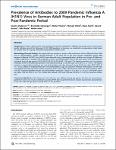Prevalence of Antibodies to 2009 Pandemic Influenza A (H1N1) Virus in German Adult Population in Pre- and Post-Pandemic Period
Dudareva, Sandra
Schweiger, Brunhilde
Thamm, Michael
Höhle, Michael
Stark, Klaus
Krause, Gérard
Buda, Silke
Haas, Walter
Background: In order to detect levels of pre-existing cross-reactive antibodies in different age groups and to measure agespecific infection rates of the influenza A (H1N1) 2009 pandemic in Germany, we conducted a seroprevalence study based on samples from an ongoing nationwide representative health survey. Methodology/Principal Findings: We analysed 845 pre-pandemic samples collected between 25 Nov 2008 and 28 Apr 2009 and 757 post-pandemic samples collected between 12 Jan 2010 and 24 Apr 2010. Reactive antibodies against 2009 pandemic influenza A (H1N1) virus (pH1N1) were detected using a haemagglutination inhibition test (antigen A/California/ 7/2009). Proportions of samples with antibodies at titre $40 and geometric mean of the titres (GMT) were calculated and compared among 6 age groups (18–29, 30–39, 40–49, 50–59, 60–69, $70 years). The highest proportions of cross-reactive antibodies at titre $40 before the pandemic were observed among 18–29 year olds, 12.5% (95% CI 7.3–19.5%). The highest increase in seroprevalence between pre- and post-pandemic was also observed among 18–29 year olds, 29.9% (95% CI 16.7–43.2%). Effects of sampling period (pre- and post-pandemic), age, sex, and prior influenza immunization on titre were investigated with Tobit regression analysis using three birth cohorts (after 1976, between 1957 and 1976, and before 1957). The GMT increased between the pre- and post-pandemic period by a factor of 10.2 (95% CI 5.0–20.7) in the birth cohort born after 1976, 6.3 (95% CI 3.3–11.9) in those born between 1957 and 1976 and 2.4 (95% CI 1.3–4.3) in those born before 1957. Conclusions/Significance: We demonstrate that infection rates differed among age groups and that the measured prepandemic level of cross-reactive antibodies towards pH1N1 did not add information in relation to protection and prediction of the most affected age groups among adults in the pandemic.
Dateien zu dieser Publikation
Keine Lizenzangabe
Verwandte Publikationen
Anzeige der Publikationen mit ähnlichem Titel, Autor, Urheber und Thema.
-
2016-02-18ZeitschriftenartikelVaccine effectiveness in preventing laboratory-confirmed influenza in primary care patients in a season of co-circulation of influenza A(H1N1)pdm09, B and drifted A(H3N2), I-MOVE Multicentre Case–Control Study, Europe 2014/15 Valenciano, Marta; Kissling, Esther; Reuss, Annicka; Rizzo, C.; Gherasim, A.; Horváth, Judit K.; Domegan, L.; Pitigoi, Daniela; Machado, Ausenda; Bella, A.; Paradowska-Stankiewicz, I.; Larrauri, A.; Ferenczi, A.; O´Donell, Joan; Lazar, M.; Pechirra, P.; Korczyńska, M. R.; Pozo, Francisco; Moren, A.Influenza A(H3N2), A(H1N1)pdm09 and B viruses co-circulated in Europe in 2014/15. We undertook a multicentre case–control study in eight European countries to measure 2014/15 influenza vaccine effectiveness (VE) against ...
-
2016-10-13ZeitschriftenartikelImproving influenza virological surveillance in Europe: strain-based reporting of antigenic and genetic characterisation data, 11 European countries, influenza season 2013/14 Broberg, E.; Hungnes, Olav; Schweiger, Brunhilde; Prosenc, Katarina; Daniels, R.; Guiomar, R.; Ikonen, N.; Kossyvakis, A.; Pozo, Francisco; Puzelli, S.; Thomas, I.; Waters, A.; Wiman, Å.; Meijer, AdamInfluenza antigenic and genetic characterisation data are crucial for influenza vaccine composition decision making. Previously, aggregate data were reported to the European Centre for Disease Prevention and Control by ...
-
2013-02-14ZeitschriftenartikelEarly estimates of seasonal influenza vaccine effectiveness in Europe: results from the i-move multicentre case–control study, 2012/13 Valenciano, M.; Kissling, E.We conducted a test-negative case–control study based in five European sentinel surveillance networks. The early 2012/13 adjusted influenza vaccine effectiveness was 78.2% (95% CI: 18.0 to 94.2) against influenza B, 62.1% ...

